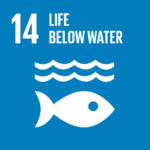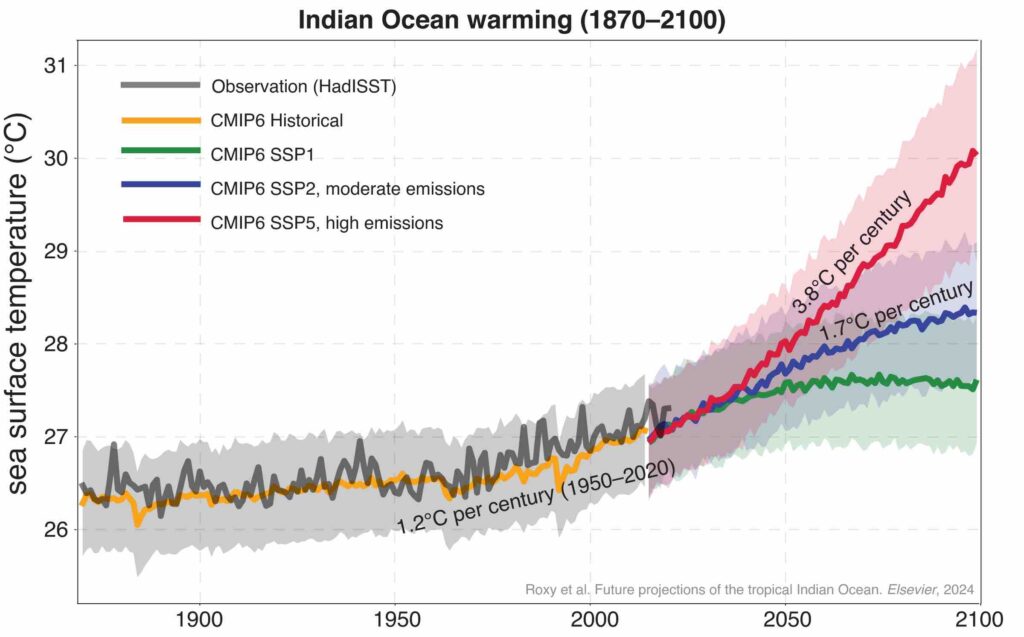A recent study led by Roxy Mathew Koll, a climate scientist at the Indian Institute of Tropical Meteorology (IITM) in Pune, warns of potential catastrophic consequences due to the rapid warming of the Indian Ocean.
A concerning new study projects significant surface warming of the Indian Ocean from 2020 to 2100, with temperatures rising between 1.4 degrees Celsius and 3 degrees Celsius. This warming is set to thrust the region into a near-constant state of marine heatwaves, escalating the frequency and intensity of cyclones, disrupting monsoon patterns, and contributing to rising sea levels.
RELEVANT SUSTAINABLE GOALS


Escalating Marine Heatwaves of Indian Ocean
Led by Roxy Mathew Koll, a prominent climate scientist at the Indian Institute of Tropical Meteorology in Pune, the research highlights a dramatic increase in the duration of marine heatwaves—abnormally high ocean temperatures—which are expected to rise from 20 days per year during the period from 1970 to 2000, to between 220 and 250 days annually by the century’s end. These extended periods of extreme heat are likely to lead to widespread ecological disruptions, including coral bleaching and the destruction of seagrass and kelp forests, with dire consequences for the fisheries industry.
Furthermore, the study, titled “Future projection for the tropical Indian Ocean,” points to a profound increase in the heat content of the ocean, extending down to depths of 2,000 meters. Currently increasing at a rate of 4.5 zetta-joules per decade, this rate is expected to surge to between 16 and 22 zetta-joules per decade in the future. Koll equates the anticipated rise in oceanic heat content to the energy release of one Hiroshima atomic bomb detonation every second, continuously, over ten years.
The study also forecasts the most significant warming to occur in the northwestern part of the Indian Ocean, including the Arabian Sea, with less pronounced warming off the coasts of Sumatra and Java.
As the ocean’s surface temperatures rise, shifts in the seasonal temperature cycle are anticipated, which could lead to more frequent and severe extreme weather events across the Indo-Pacific region. While basin-average maximum temperatures in the Indian Ocean typically ranged from 26 degrees Celsius to 28 degrees Celsius annually from 1980 to 2020, the study predicts that by the end of the 21st century, even the minimum temperatures will not drop below 28.5 degrees Celsius to 30.7 degrees Celsius under high emission scenarios.
Additionally, significant changes are expected in the Indian Ocean Dipole, an important factor in monsoon dynamics and cyclone formation. The frequency of extreme dipole events is predicted to rise by 66%, while moderate events may decrease by 52% by the end of the 21st century, potentially leading to significant alterations in regional weather patterns.
The study also anticipates an increase in ocean acidification, with surface pH levels projected to drop from above 8.1 to below 7.7 by the century’s end. This acidification, coupled with a predicted 8-10% decline in surface chlorophyll and net primary productivity in regions like the western Arabian Sea, underscores the broader environmental shifts underway.
With the Indian Ocean bordering 40 countries and home to a third of the world’s population, these predicted changes are of great concern, as they will likely have profound impacts on societal structures and economies across a significant portion of the globe.



